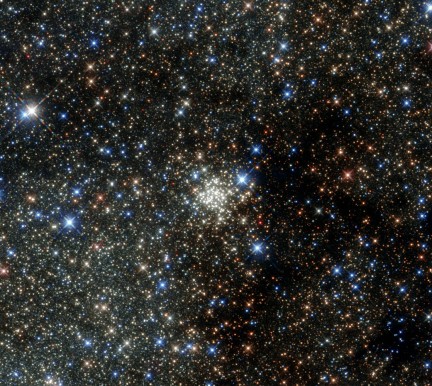星に命があると信じて。
2015.11.08
いまよりも、うんと闇が深くて長かった時代
ひとびとは夜空に瞬く星には、命があると考えていました。
満天の星空を見上げては、
まるで会話するように、その瞬きを眺めていたのでしょう。
あまた浮かぶ星たちに、
一定のルールがあると気付いたのも、
いったいどれほど眺めればそれに気が付けるものなのか。
思えば思うほど、頭の下がる気持になります。
一日は24時間で、一時間は60分だという時間さえ
きっと、現代とは比べ物にならないのでしょう。
「時間」という概念を、ときには忘れてみたくなる。
そんな悠久の宇宙を、星をテーマにした
ソラの読書サロンがございます。
12月9日(水)19時~21時
“粒粒”の特製ごはんと、“ハチマクラ”のお任せおみやげ付き
おひとりさま3,000円にて
くわしくは http://bihadasora.com/archives/12608
写真はこちらより。

This new NASA/ESA Hubble Space Telescope image presents the Arches Cluster, the densest known star cluster in the Milky Way. It is located about 25 000 light-years from Earth in the constellation of Sagittarius (The Archer), close to the heart of our galaxy, the Milky Way. It is, like its neighbour the Quintuplet Cluster, a fairly young astronomical object at between two and four million years old. The Arches cluster is so dense that in a region with a radius equal to the distance between the Sun and its nearest star there would be over 100 000 stars! At least 150 stars within the cluster are among the brightest ever discovered in the the Milky Way. These stars are so bright and massive, that they will burn their fuel within a short time, on a cosmological scale, just a few million years, and die in spectacular supernova explosions. Due to the short lifetime of the stars in the cluster, the gas between the stars contains an unusually high amount of heavier elements, which were produced by earlier generations of stars. Despite its brightness the Arches Cluster cannot be seen with the naked eye. The visible light from the cluster is completely obscured by gigantic clouds of dust in this region. To make the cluster visible astronomers have to use detectors which can collect light from the X-ray, infrared, and radio bands, as these wavelengths can pass through the dust clouds. This observation shows the Arches Cluster in the infrared and demonstrates the leap in Hubble’s performance since its 1999 image of same object.




